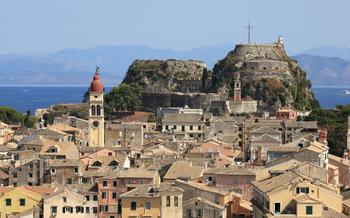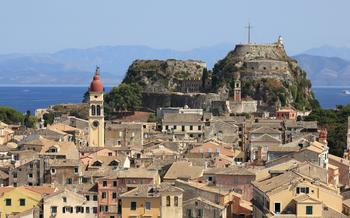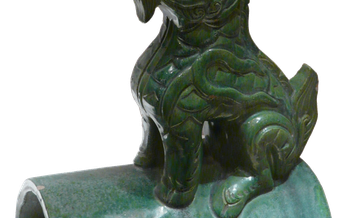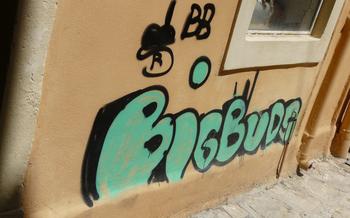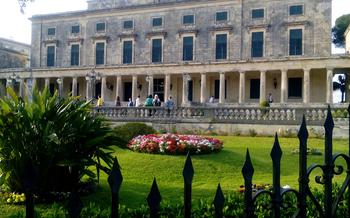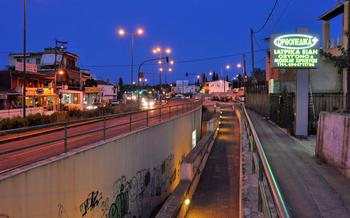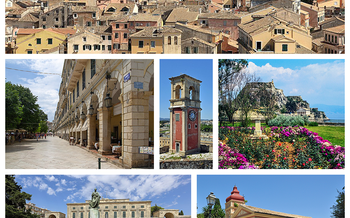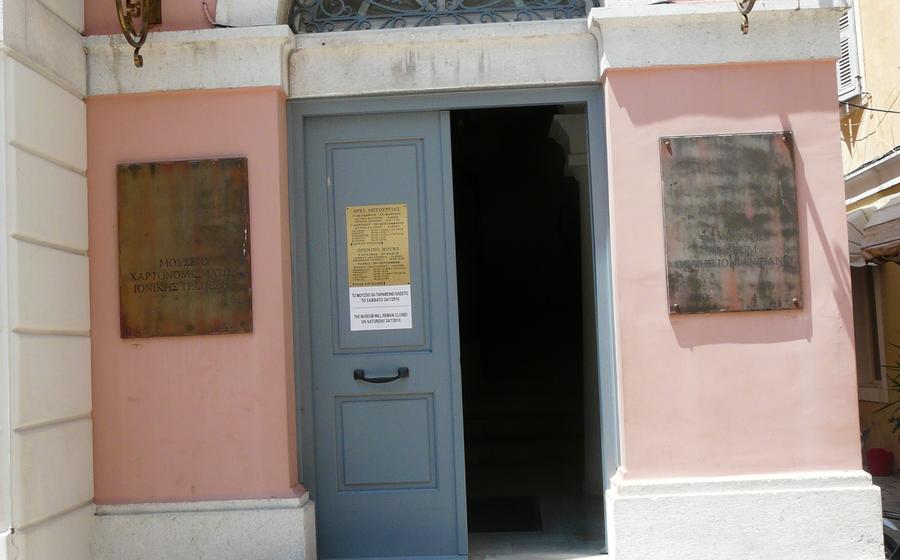
Museum of Banknotes
- Historical Background:
- Museum's Location: A Journey Through History and Currency
- Opening Hours and Admission:
- Exhibits and Displays
- Interactive Elements
- Educational Programs
- Temporary Exhibitions
- Museum Shop
- Accessibility for Disabled Visitors
- Photography and Videography
- Guided Tours
- Nearby Attractions
- Suggested Itineraries
- Tips for Visitors: Making the Most of Your Visit
- Insider Tip:
Historical Background:
The Museum of Banknotes in Corfu offers a fascinating journey through the history of paper money in Greece. Established by the Bank of Greece, the museum showcases the evolution of Greek banknotes from their humble beginnings to their modern, secure form. Corfu played a significant role in this evolution, serving as a major center for the production and distribution of banknotes during the 19th century. Visitors can learn about the intricate processes involved in banknote design and printing, as well as the security features that have been developed over time to combat counterfeiting. The museum's collection includes rare and valuable banknotes, historical documents, and artifacts that provide a comprehensive overview of the history of Greek currency.
Museum's Location: A Journey Through History and Currency
The Museum of Banknotes in Corfu is a treasure trove of monetary history, nestled in the heart of the city. To reach this sanctuary of paper currency, make your way to Ioannis Theotoki Street, where the museum proudly stands. This vibrant street, lined with historical buildings, leads you to the museum's entrance, inviting you to delve into the fascinating world of Greek banknotes.
For those arriving by car, ample parking is available nearby, allowing you to seamlessly transition from the bustling city streets to the tranquil embrace of the museum. If you prefer to explore Corfu's charming alleys on foot, the museum is easily accessible by following the picturesque labyrinth of streets.
The museum's proximity to other landmarks enhances its allure. Just a stone's throw away, you'll find the Old Town of Corfu, a UNESCO World Heritage Site, beckoning you to discover its Venetian-style architecture and rich history. For those seeking a spiritual retreat, the Church of Panagia Spiliotissa, with its stunning Byzantine architecture, is a short walk from the museum.
The Museum of Banknotes is fully accessible, welcoming visitors of all abilities. Ramps and elevators ensure that everyone can navigate the museum's spaces effortlessly. The museum's commitment to inclusivity extends to providing audio guides for visitors with visual impairments, ensuring that everyone can embark on a journey through the evolution of Greek currency.
Opening Hours and Admission:
The Museum of Banknotes in Corfu welcomes visitors during specific operating hours to ensure an organized and enjoyable experience. The museum's doors are open from Tuesday to Sunday, allowing visitors to explore the world of banknotes at their convenience. However, it's worth noting that the museum remains closed on Mondays, providing an opportunity for maintenance and preparation for the upcoming week.
Admission to the Museum of Banknotes is subject to a modest fee, which helps support the preservation and upkeep of this unique collection. The standard admission price is designed to be accessible to visitors from all backgrounds, allowing everyone to delve into the fascinating history of Greek banknotes. Additionally, the museum offers discounted rates for students, seniors, and groups, encouraging educational and cultural exploration among various demographics.
Guided tours are available upon request, providing visitors with an in-depth understanding of the exhibits and the stories behind them. These tours are led by knowledgeable and passionate guides who bring the museum's collection to life, offering insights into the significance of banknotes in Greek history and culture. Whether you prefer to explore independently or with the guidance of an expert, the Museum of Banknotes offers a welcoming and informative experience for all visitors.
Exhibits and Displays
The Museum of Banknotes in Corfu houses a diverse collection of exhibits and displays that take visitors on a journey through the fascinating world of Greek currency. Among the highlights are rare and unique banknotes from the early days of the Bank of Greece, showcasing the evolution of banknote design and security features over time. Visitors can marvel at the intricate details, vibrant colors, and symbolic motifs that adorn these historic banknotes, each telling a story of Greece's economic and cultural heritage.
In addition to banknotes, the museum also displays historical documents, artifacts, and machinery related to the production and circulation of Greek currency. These exhibits provide insights into the processes involved in creating and managing banknotes, from the design and printing stages to the distribution and security measures employed to prevent counterfeiting. Visitors can learn about the challenges and innovations that have shaped the history of Greek banknotes, gaining a deeper understanding of the role they have played in the nation's financial and economic development.
One of the most captivating exhibits is the "Banknote of the Year" display, which showcases the winning designs from an annual competition held by the Bank of Greece. These banknotes are selected for their artistic merit, historical significance, and innovative security features, offering visitors a glimpse into the future of Greek currency.
The museum also features interactive exhibits that allow visitors to engage with the history and evolution of banknotes in a hands-on manner. Visitors can learn about the different types of paper and inks used in banknote production, test their skills at identifying counterfeit banknotes, and even create their own virtual banknotes using a digital design tool. These interactive elements add a dynamic and engaging dimension to the museum experience, making it accessible and enjoyable for visitors of all ages.
Interactive Elements
The Museum of Banknotes in Corfu isn't just a static display of historical currency; it also features interactive elements that bring the exhibits to life and enhance the visitor experience. One of the most popular interactive exhibits is a virtual reality tour that takes visitors on a journey through the history of Greek banknotes. Visitors can don VR headsets and immerse themselves in a virtual world where they can see and interact with historic banknotes, printing presses, and other artifacts.
Another interactive exhibit allows visitors to design their own banknotes. Using a touch screen interface, visitors can choose from a variety of templates and design elements to create their own unique currency. They can even print out their creations as a souvenir.
These interactive elements not only make the museum more engaging and enjoyable for visitors, but they also help to educate them about the history and evolution of banknotes. By interacting with the exhibits, visitors can gain a deeper understanding of the role that paper money has played in Greek society and culture.
In my experience, the interactive exhibits at the Museum of Banknotes were a great way to learn about the history of Greek currency in a fun and engaging way. I especially enjoyed the VR tour, which allowed me to see and interact with historic banknotes in a way that would not have been possible otherwise.
Educational Programs
The Museum of Banknotes in Corfu offers a range of educational programs and workshops designed to engage students, groups, and visitors of all ages with the fascinating world of banknotes and monetary history. These programs delve into the history, design, and security features of banknotes, providing a unique learning experience that combines education with hands-on activities.
One of the most popular programs is the "Banknote Design Workshop," where participants learn about the intricate process of designing and creating banknotes. They get to design their own banknotes, exploring the various elements and security features that make each note unique. The workshop fosters creativity, problem-solving skills, and an appreciation for the art and science behind banknotes.
For younger visitors, the museum offers interactive storytelling sessions that bring to life the stories behind some of the most iconic banknotes in Greek history. Through engaging narratives and hands-on activities, children learn about the historical events, cultural influences, and economic significance of these banknotes.
The museum also collaborates with local schools to offer educational tours and workshops tailored to different grade levels. These programs align with school curricula, providing students with a deeper understanding of monetary history, economics, and the role of central banks in modern society.
Success stories abound from participants who have attended these educational programs. Teachers have praised the museum's ability to captivate students and make learning about banknotes fun and interactive. Students have expressed their fascination with the history of money and the opportunity to design their own banknotes.
The Museum of Banknotes in Corfu is committed to providing educational experiences that inspire, engage, and empower visitors of all ages. Through its diverse range of programs and workshops, the museum plays a vital role in promoting financial literacy, historical awareness, and a deeper appreciation for the world of banknotes.
Temporary Exhibitions
In addition to its permanent displays, the Museum of Banknotes also hosts temporary exhibitions that delve into specific themes or topics related to currency and finance. These exhibitions provide visitors with an opportunity to explore unique aspects of the world of banknotes and gain a deeper understanding of their significance.
The themes of these temporary exhibitions can vary widely, from the history of a particular currency to the evolution of banknote design or the role of banknotes in global trade. The museum collaborates with experts and institutions to curate these exhibitions, ensuring that visitors have access to the latest research and insights on these topics.
Temporary exhibitions are typically held for a limited period, ranging from a few weeks to several months. This allows the museum to present a diverse range of topics and keep its exhibits fresh and engaging for visitors.
Whether you're a history buff, a finance enthusiast, or simply curious about the world of banknotes, the temporary exhibitions at the Museum of Banknotes offer a valuable opportunity to learn and discover more. Check the museum's website or inquire at the information desk for details on current and upcoming exhibitions.
Museum Shop
Within the museum's premises, visitors will find a well-stocked museum shop offering a range of souvenirs, books, and merchandise related to the history of banknotes and currency. From commemorative coins and replicas of historical banknotes to educational books and posters, the shop provides a unique opportunity to take home a piece of the museum's collection.
For those looking for a special memento, I highly recommend the museum's exclusive range of handmade replicas of Greek banknotes. These replicas are meticulously crafted using traditional techniques, ensuring their authenticity and durability. Whether you're a collector or simply looking for a unique gift, these replicas are a must-have.
The museum shop also offers a selection of books and publications on the history of money, banknote design, and the evolution of currency. These books provide in-depth insights into the world of banknotes and are perfect for those who want to learn more about this fascinating subject.
Accessibility for Disabled Visitors
The Museum of Banknotes in Corfu is committed to ensuring that all visitors, regardless of their abilities, have an enjoyable and accessible experience. The museum features several accessibility features to accommodate visitors with disabilities, making it a welcoming and inclusive space for everyone.
Wheelchair ramps and elevators provide easy access to all floors of the museum, allowing visitors to explore the exhibits without barriers. Accessible restrooms are also available, ensuring convenience and comfort for visitors with mobility challenges.
In addition, the museum staff is trained to assist visitors with disabilities, providing any necessary assistance or information to ensure a smooth and enjoyable visit. Visitors who require assistance are encouraged to contact the museum in advance to make arrangements and ensure that their needs are met.
The Museum of Banknotes' commitment to accessibility extends to its website as well. The museum's website is designed to be accessible to visitors with disabilities, featuring features such as screen readers and keyboard navigation. This allows visitors to easily browse the museum's exhibits, plan their visit, and access information about the museum's accessibility features.
Photography and Videography
The Museum of Banknotes encourages visitors to capture their experiences through photography and videography, as long as they adhere to certain guidelines. Flash photography is prohibited to prevent damage to the delicate exhibits, and tripods are not allowed to ensure the safety of visitors and artifacts. While capturing the beauty of the museum and its exhibits is encouraged, visitors are kindly requested to respect the privacy of other visitors and refrain from taking photos or videos of them without their consent. By following these simple guidelines, visitors can create lasting memories of their visit to the Museum of Banknotes while respecting its rules and preserving its treasures for future generations.
Guided Tours
The Museum of Banknotes offers guided tours that provide visitors with a deeper insight into the history of Greek banknotes and the significance of the exhibits. These tours are led by knowledgeable guides who share fascinating stories and anecdotes related to the banknotes on display. Visitors can learn about the evolution of banknote design, security features, and the role of the Bank of Greece in shaping the nation's financial system. Guided tours are available in various languages and can be booked in advance or on-site, subject to availability.
During my visit to the museum, I had the opportunity to join a guided tour led by an enthusiastic and passionate guide. She brought the stories behind the banknotes to life, sharing intriguing details about their historical context and the personalities featured on them. The tour was informative and engaging, enhancing my appreciation for the museum's collection.
Whether you're a history buff, a currency enthusiast, or simply curious about the world of banknotes, I highly recommend taking a guided tour at the Museum of Banknotes. It's a great way to gain a deeper understanding of the fascinating stories and significance of the exhibits.
Nearby Attractions
After exploring the fascinating world of banknotes at the Museum of Banknotes, visitors can venture out to discover the many other attractions that Corfu has to offer. Just a short walk away, the Old Town of Corfu, a UNESCO World Heritage Site, beckons with its narrow cobblestone streets, Venetian architecture, and lively atmosphere. Here, visitors can wander through the bustling markets, visit the iconic Corfu Palace, or relax in one of the many charming cafés.
For those seeking a beach escape, the picturesque shores of Glyfada Beach are just a 15-minute drive from the museum. This beautiful beach offers crystal-clear waters, soft golden sand, and stunning views of the Ionian Sea. Visitors can spend the day swimming, sunbathing, or indulging in water sports like jet skiing or parasailing.
History buffs will appreciate a visit to the Corfu War Museum, which showcases the island's rich military history and its role in various conflicts throughout the centuries. The museum displays a fascinating collection of artifacts, uniforms, and weapons, providing visitors with a deeper understanding of Corfu's past.
For a unique cultural experience, visitors can head to the Corfu Museum of Asian Art, which houses a remarkable collection of Asian art and artifacts from countries such as China, Japan, and India. The museum's exhibits offer a glimpse into the diverse artistic traditions and cultural heritage of Asia.
Suggested Itineraries
Visiting the Museum of Banknotes can be easily combined with other attractions and activities in Corfu. For a comprehensive cultural experience, start your day by exploring the museum's exhibits, delving into the history of Greek currency and the evolution of banknotes. From there, take a short walk to the nearby Corfu Old Town, a UNESCO World Heritage Site. Stroll through its narrow streets, admire the Venetian architecture, and visit historical landmarks like the Old Fortress and the Corfu Palace.
For a more relaxed itinerary, head to one of Corfu's stunning beaches after your museum visit. The island boasts crystal-clear waters and picturesque coastlines, making it a haven for sunseekers and water sports enthusiasts. Enjoy a refreshing swim, bask in the warm Greek sun, or try your hand at activities like snorkeling, diving, or sailing.
Alternatively, if you're interested in delving deeper into Corfu's rich history and culture, consider visiting the Archaeological Museum of Corfu, which houses a collection of artifacts from the island's ancient past. You can also visit the Byzantine Museum of Corfu to explore the island's Byzantine heritage and admire its collection of icons and religious artifacts.
Tips for Visitors: Making the Most of Your Visit
To fully appreciate your visit to the Museum of Banknotes, here are some valuable tips:
-
Plan your visit during the off-season (October to April) to avoid crowds and enjoy a more relaxed experience.
-
Take advantage of guided tours, especially if you're interested in learning in-depth about the history of banknotes and their significance in Greece.
-
Don't hesitate to ask questions to the museum staff or tour guides. They are knowledgeable and passionate about the subject and can provide valuable insights.
-
Combine your visit to the museum with other attractions in Corfu. The Old Town and the Corfu Palace are within walking distance, and the stunning beaches of Paleokastritsa are just a short drive away.
-
Allow enough time to explore the museum's exhibits thoroughly. There's a wealth of information and artifacts to discover, so don't rush through your visit.
-
Take advantage of the museum's educational programs if you're traveling with children or as a group. These programs offer interactive and engaging ways to learn about the world of banknotes.
-
The museum shop offers a variety of souvenirs and books related to the history of banknotes. Consider purchasing a commemorative item to remember your visit.
Insider Tip:
Unveiling a hidden gem within the Museum of Banknotes, visitors can discover a secret vault that houses a collection of rare and valuable banknotes not displayed in the main exhibits. This exclusive treasure trove includes limited-edition commemorative notes, experimental designs, and prototypes that offer a glimpse into the fascinating world of banknote creation. To access this hidden vault, visitors must request a special guided tour, which provides an intimate and unforgettable experience. Remember to inquire about the secret vault when booking your tour, as spaces are limited and subject to availability. Immerse yourself in the rich history and artistry of Greek banknotes as you explore this hidden gem, gaining a deeper appreciation for the craftsmanship and significance of these monetary treasures.
